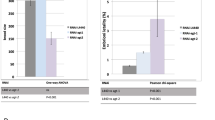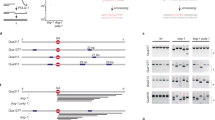Abstract
Genetic integrity is crucial to normal cell function, and mutations in genes required for DNA replication and repair underlie various forms of genetic instability and disease, including cancer1. One structural feature of intact genomes is runs of homopolymeric dC/dG. Here we describe an unusual mutator phenotype in Caenorhabditis elegans characterized by deletions that start around the 3′ end of polyguanine tracts and terminate at variable positions 5′ from such tracts. We observed deletions throughout genomic DNA in about half of polyguanine tracts examined, especially those containing 22 or more consecutive guanine nucleotides. The mutator phenotype results from disruption of the predicted gene F33H2.1, which encodes a protein with characteristics of a DEAH helicase and which we have named dog-1 (for deletions of guanine-rich DNA). Nematodes mutated in dog-1 showed germline as well as somatic deletions in genes containing polyguanine tracts, such as vab-1. We propose that DOG-1 is required to resolve the secondary structures of guanine-rich DNA that occasionally form during lagging-strand DNA synthesis.
This is a preview of subscription content, access via your institution
Access options
Subscribe to this journal
Receive 12 print issues and online access
$209.00 per year
only $17.42 per issue
Buy this article
- Purchase on Springer Link
- Instant access to full article PDF
Prices may be subject to local taxes which are calculated during checkout




Similar content being viewed by others
References
Hoeijmakers, J.H.J. Genome maintenance mechanisms for preventing cancer. Nature 411, 366–374 (2001).
Sen, D. & Gilbert, W. Formation of parallel four-stranded complexes by guanine-rich motifs in DNA and its implications for meiosis. Nature 334, 364–366 (1988).
Williamson, J.R., Raghuraman, M.K. & Cech, T.R. Monovalent cation-induced structure of telomeric DNA: the G-quartet model. Cell 59, 871–880 (1989).
Simonsson, T. G-quadruplex DNA structures—variations on a theme. Biol. Chem. 382, 621–628 (2001).
Bork, P. & Koonin, E.V. An expanding family of helicases within the 'DEAD/H' superfamily. Nucleic Acids Res. 21, 751–752 (1993).
Brenner, S. The genetics of Caenorhabditis elegans. Genetics 77, 71–94 (1974).
George, S.E., Simokat, K., Hardin, J. & Chisholm, A.D. The VAB-1 Eph receptor tyrosine kinase functions in neural and epithelial morphogenesis in C. elegans. Cell 92, 633–643 (1998).
Wicky, C. et al. Telomeric repeats (TTAGGC)n are sufficient for chromosome capping function in Caenorhabditis elegans. Proc. Natl Acad. Sci. USA 93, 8983–8988 (1996).
Trinh, T.Q. & Sinden, R.R. Preferential DNA secondary structure mutagenesis in the lagging strand of replication in E. coli. Nature 352, 544–547 (1991).
Kang, S., Jaworski, A., Ohshima, K. & Wells, R.D. Expansion and deletion of CTG repeats from human disease genes are determined by the direction of replication in E. coli. Nature Genet. 10, 213–218 (1995).
Hirst, M.C. & White, P.J. Cloned human FMR1 trinucleotide repeats exhibit a length- and orientation-dependent instability suggestive of in vivo lagging strand secondary structure. Nucleic Acids Res. 26, 2353–2358 (1998).
Rolfsmeier, M.L. et al. Cis-elements governing trinucleotide repeat instability in Saccharomyces cerevisiae. Genetics 157, 1569–1579 (2001).
Balakumaran, B.S., Freudenreich, C.H. & Zakian, V.A. CGG/CCG repeats exhibit orientation-dependent instability and orientation-independent fragility in Saccharomyces cerevisiae. Hum. Mol. Genet. 9, 93–100 (2000).
Ahmed, S. & Hodgkin, J. MRT-2 checkpoint protein is required for germline immortality and telomere replication in C. elegans. Nature 403, 159–164 (2000).
Gartner, A., Milstein, S., Ahmed, S., Hodgkin, J. & Hengartner, M.O. A conserved checkpoint pathway mediates DNA damage–induced apoptosis and cell cycle arrest in C. elegans. Mol. Cell 5, 435–443 (2000).
Strand, M., Prolla, T.A., Liskay, R.M. & Petes, T.D. Destabilization of tracts of simple repetitive DNA in yeast by mutations affecting DNA mismatch repair. Nature 365, 274–276 (1993).
Degtyareva, N.P. et al. Caenorhabditis elegans DNA mismatch repair gene msh-2 is required for microsatellite stability and maintenance of genome integrity. Proc. Natl Acad. Sci. USA 99, 2158–2163 (2002).
Dalgaard, J.Z. & Klar, A.J. A DNA replication-arrest site RTS1 regulates imprinting by determining the direction of replication at mat1 in S. pombe. Genes Dev. 15, 2060–2068 (2001).
Seydoux, G. & Schedl, T. The germline in C. elegans: origins, proliferation, and silencing. Int. Rev. Cytol. 203, 139–185 (2001).
Reinke, V. et al. A global profile of germline gene expression in C. elegans. Mol. Cell 6, 605–616 (2000).
Zetka, M.C. & Rose, A.M. Mutant rec-1 eliminates the meiotic pattern of crossing over in Caenorhabditis elegans. Genetics 141, 1339–1349 (1995).
Dempsey, L.A., Sun, H., Hanakahi, L.A. & Maizels, N. G4 DNA binding by LR1 and its subunits, nucleolin and hnRNP D. A role for G-G pairing in immunoglobulin switch recombination. J. Biol. Chem. 274, 1066–1071 (1999).
Sun, H., Karow, J.K., Hickson, I.D. & Maizels, N. The Bloom's syndrome helicase unwinds G4 DNA. J. Biol. Chem. 273, 27587–27592 (1998).
Mohaghegh, P., Karow, J.K., Brosh, J.R. Jr, Bohr, V.A. & Hickson, I.D. The Bloom's and Werner's syndrome proteins are DNA structure-specific helicases. Nucleic Acids Res. 29, 2843–2849 (2001).
Kamath-Loeb, A.S., Loeb, L.A., Johansson, E., Burgers, P.M. & Fry, M. Interactions between the Werner syndrome helicase and DNA polymerase δ specifically facilitate copying of tetraplex and hairpin structures of the d(CGG)n trinucleotide repeat sequence. J. Biol. Chem. 276, 16439–16446 (2001).
Cantor, S.B. et al. BACH1, a novel helicase-like protein, interacts directly with BRCA1 and contributes to its DNA repair function. Cell 105, 149–160 (2001).
Kamath, R.S., Martinez-Campos, M., Zipperlen, P., Fraser, A.G. & Ahringer, J. Effectiveness of specific RNA-mediated interference through ingested double-stranded RNA in Caenorhabditis elegans. Genome Biol. 2, research0002.1–research0002.10 (2000).
Fraser, A.G. et al. Functional genomic analysis of C. elegans chromosome I by systematic RNA interference. Nature 408, 325–330 (2000).
Acknowledgements
This paper is dedicated to the memory of M. Smith, who died in October 2000. We thank D. Baillie for discussion and help with the analysis, R. Kay for critical reading of the manuscript and V. Vijayaratnam for outcrossing the gk10 strain. This work was supported by a grant from the National Cancer Institute of Canada with funds from the Terry Fox Run and by grants from the Canadian Institute of Health Research (A.R. and P.L.). I.C. was supported by a studentship from the University of British Columbia.
Author information
Authors and Affiliations
Corresponding author
Ethics declarations
Competing interests
The authors declare no competing financial interests.
Supplementary information
Rights and permissions
About this article
Cite this article
Cheung, I., Schertzer, M., Rose, A. et al. Disruption of dog-1 in Caenorhabditis elegans triggers deletions upstream of guanine-rich DNA. Nat Genet 31, 405–409 (2002). https://doi.org/10.1038/ng928
Received:
Accepted:
Published:
Issue Date:
DOI: https://doi.org/10.1038/ng928
This article is cited by
-
G4-quadruplex-binding proteins: review and insights into selectivity
Biophysical Reviews (2022)
-
Promoter G-quadruplexes and transcription factors cooperate to shape the cell type-specific transcriptome
Nature Communications (2021)
-
G-quadruplexes originating from evolutionary conserved L1 elements interfere with neuronal gene expression in Alzheimer’s disease
Nature Communications (2021)
-
Helicase Q promotes homology-driven DNA double-strand break repair and prevents tandem duplications
Nature Communications (2021)
-
G-quadruplex DNA: a novel target for drug design
Cellular and Molecular Life Sciences (2021)



